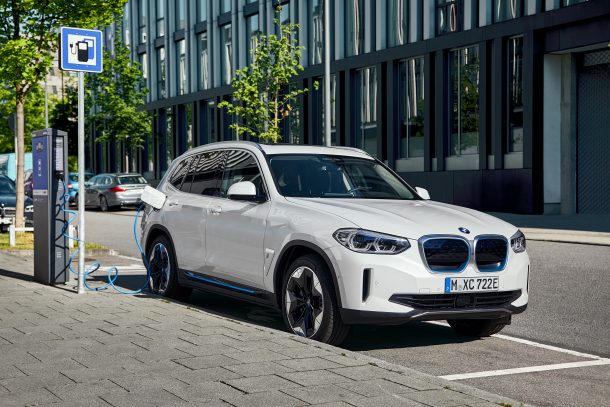BMW Debuts IX3: INext, Please

BMW revealed the production version of the iX3 crossover this week, adhering as closely to the 2018 concept as possible. More aerodynamic than your standard X3 and adorned with visual cues hinting at its status as a zero-emissions vehicle, Bavaria’s newest electric seems adequate transportation for those with modest expectations.
But this is supposed to be the first vehicle in the brand’s upcoming product offensive, a strategy aimed at helping it transition into the next Tesla or whatever fantasy scenario corporate leadership has deluded themselves into. Forget the i3 — this is what it looks like when BMW gets serious about electrification. That’s the marketing line being used to stir interest, at least. However, it starts to unravel a bit when you look at the vehicle’s capabilities and planned trajectory.
The iX3 will launch in the Chinese market first, with Europe not seeing deliveries until 2021. It uses the company’s flexible vehicle architecture, allowing it to be manufactured alongside hybrid and internal-combustion X3s in Shenyang as part of its joint venture with Brilliance Automotive. That likewise makes the model a swell opportunity to prove BMW’s commitment to the region, allowing it continued access China’s vast consumer market and affordable labor force.
That said, the rear-drive crossover isn’t worth writing home about. The standard four-cylinder or inline-six motors found in the X3 have been supplanted by an electric unit outputting 210 kW/286 hp, with peak torque coming in around 400 Nm (295 lb-ft). BMW estimates a 0-60 mph time of 6.8 seconds with a range of 285 miles (based on the European WLTP test cycle) and an electronically limited top speed of 112 mph.
On paper, this makes the iX3 a worse performer than Hyundai’s all-electric Kona — which starts at $37,000. The BMW is said to retail around €69,000 when it drops in Europe.
Granted, it’s a larger vehicle and comes with a fancier emblem. But it doesn’t break away from other EVs in its own segment and will certainly be outclassed when Ford’s Mach-E goes on sale. The competition isn’t likely to weaken after that.
The iX3’s 80 kWh battery can be recharged swiftly, however. BMW estimated it takes just 34 minutes to regain 80 percent of its maximum charge if a DC fast-charging station can be found to utilize its 150 kW capacity. While not groundbreaking, it will help to make the model more livable as a daily conveyance.
If that doesn’t endear you to the car, you probably won’t have to confront it in person unless you’re a frequent traveler. While BMW wants to export the car globally from China, there are no plans in place to send it to North America at present. Even if that changes, we don’t imagine seeing more than a handful milling around select Californian cities before it’s replaced with something better (iNext perhaps) or just pulled off the market.
[Images: BMW]

A staunch consumer advocate tracking industry trends and regulation. Before joining TTAC, Matt spent a decade working for marketing and research firms based in NYC. Clients included several of the world’s largest automakers, global tire brands, and aftermarket part suppliers. Dissatisfied with the corporate world and resentful of having to wear suits everyday, he pivoted to writing about cars. Since then, that man has become an ardent supporter of the right-to-repair movement, been interviewed on the auto industry by national radio broadcasts, driven more rental cars than anyone ever should, participated in amateur rallying events, and received the requisite minimum training as sanctioned by the SCCA. Handy with a wrench, Matt grew up surrounded by Detroit auto workers and managed to get a pizza delivery job before he was legally eligible. He later found himself driving box trucks through Manhattan, guaranteeing future sympathy for actual truckers. He continues to conduct research pertaining to the automotive sector as an independent contractor and has since moved back to his native Michigan, closer to where the cars are born. A contrarian, Matt claims to prefer understeer — stating that front and all-wheel drive vehicles cater best to his driving style.
More by Matt Posky
Latest Car Reviews
Read moreLatest Product Reviews
Read moreRecent Comments
- SCE to AUX Sure, give them everything they want, and more. Let them decide how long they keep their jobs and their plant, until both go away.
- SCE to AUX Range only matters if you need more of it - just like towing capacity in trucks.I have a short-range EV and still manage to put 1000 miles/month on it, because the car is perfectly suited to my use case.There is no such thing as one-size-fits all with vehicles.
- Doug brockman There will be many many people living in apartments without dedicated charging facilities in future who will need personal vehicles to get to work and school and for whom mass transit will be an annoying inconvenience
- Jeff Self driving cars are not ready for prime time.
- Lichtronamo Watch as the non-us based automakers shift more production to Mexico in the future.






































Comments
Join the conversation
Well it's no Tesla, meaning it will probably be painted correctly, have actual switchgear, and an interior befitting a luxury car. And it doesn't look like a jelly bean. Give me Tesla's drive train in a BMW body/interior, for 50 large. Then you'd have something...
I get why BMW priced it this way. They know that there will be no market to sell water pumps every 60k miles and all flavor of gaskets every 90k miles, so they had to price those missed repairs into the MSRP of a vehicle. Good news - from BMWs perspective - is that there will still be a robust market for blower motors, window regulators, door lock actuators, etc, etc.